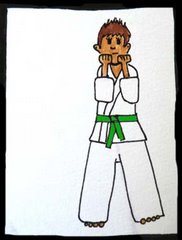After waking lazily in my nice hotel room, I borrowed a bike and headed off to find Nara Park and its famed deer, with whom I had a long-standing appointment. I managed to get lost on my way over there, not unusual for me but somewhat embarrassing in a town as small as Nara! I eventually found the paved tourist street heading up the hill and to my utmost delight found a shop devoted entirely to calligraphy products. I had spent the previous few weeks being frustrated by my inability to find places to buy supplies (not helped by my lack of linguistic and cultural understanding) and now found myself the kid in the proverbial candy store. Art supply stores are my favourite shops after bookstores, and this was one of the strongest Japanese ilk. A strong smell of sumi pervaded the air and took me to a bygone era steeped in tradition, as it does everytime I walk into the hushed stillness of my shuji classroom.
I was standing in this small shop, soaking up the lush zen-ness of the atmosphere and the close proximity of so many luxurious objects, when the store owner came gingerly over to ask if he could help. I was standing over the marble hanko stones, the stamps Japanese people use to sign their names; calligraphy ones are usually square instead of round and and engraved with an older style of kanji, the name of which I don't know. From a typographic design point of view, I like it much more than the standard kanji used for printing or the cursive style for writing.
Over previous weeks I had meticulously gathered a modest collection of ink, paper, brushes and a really nice ink stone, the "four treasures" needed for calligraphy, but a hanko was the one thing I had secretly wanted for a long time, but had never really been motivated enough to organise. Japanese friends and teachers had somehow infused with an idea that it was very difficult to organise and not really necessary. After we exchanged preliminaries over what I wanted, he must have sensed my unsure desire and he expertly guided me out to the back to his office whereby he managed to iron out all the problems of creating and delivering my hanko. He was really patient with my japanese and we methodically went through the logistics and costs involved of getting me my own original hanko.
The stones themselves vary in size but are usually about 5cm long with an engraved face about 1-2cm squared. The stones themselves are quite cheap, but the engraving of each character costs about $25 each, and most people have 2-3 characters in their name. It would take a week to 10 days to get the engraving done, and then he would send the finished product to my mum's house in Australia. I bought some of the firm red ink that sits in a beautiful Chinese style pot inside a beautiful box covered in green Chinese silk and he showed my how to use and care for my ink. After finalising everything and dumping it on my visa card, I tripped up the hill to meet my deer friends, happy with both my transaction and my ability to complete it in Japanese.
It was only the next day that I found out that Nara is considered the centre of calligraphy in Japan. Before running out to the airport in the evening I managed to find a different shop where I bought a book and some beautiful paper.
This is the finished result that I received in the post.



1 comment:
Beautiful rakkan 落款; I think you easily got your money's worth. I carve my own seals, but they aren't so elegant as that.
The family of scripts used for the seals is referred to as tenshotai 篆書体. The specific script used for your seal is called shoutenshotai 小篆書体, or lesser seal script.
Sorry to hear you departed Japan. At least you collected the "five" treasures, so you can practice your arts at home. I like going to Todaiji. Not to see the building or Daibutsu, but rather to watch the calligrapher near the exit. He puts all sorts of charms and gods into paper seal for people to attach to their walls at home. He is very adept.
Post a Comment